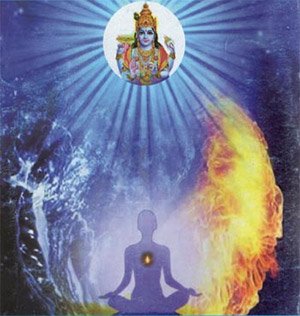Siddhanta Sangraha of Sri Sailacharya
by E. Sowmya Narayanan | 2008 | 30,562 words
Siddhanta Sangraha Chapter 12 (English translation), entitled “not inert substances” as included in the critical edition and study. The Siddhanta Samgraha is a Sanskrit philosophical text dealing with Vishishtadvaita in five hundred Sanskrit verses. It was written by Shri Shailacarya (18th century) and closely follows the philosophy of Vedanta Deshika (13th century).
Chapter 12 - Not inert substances
121-122. Thus, the two fold divisions of the inert substances (jaḍa dravya) namely the unmanifest and time are explained. The tattvas based on the substances which are not-inert (ājaḍa) are classified into four namely jīva (the individual soul), Īśvara, dharmabhūtajñāna (attributive consciousness) and nitya vibhūti (eternal abode of God). The definition of the individual soul is that being sentient He is atomic in size.
123. The phrase atomic (aṇutva) is used to avoid the defect of over applicability (ativyāpti) in the case of Īśvara.[1] The soul is always associated with the aspect pratyaktva.[2]
124. It is always subjects to the cognition of ‘I’ ness. Even in the state of sleep there is the notion of ‘I’ ness and this has been explained in the Śrī Bhāṣya.
125. Therefore the ahantva is termed as pratyaktva and it is always adjectival to T. The ātmā which is associated with ‘I’ ness will not be realized without ahantva. Here, the view of Advaitins that the ātmā is nirviśesa (devoid of any attribute) is not accepted.
126. This aspect has been explained in the Tattvaṭīka, Sarvārthasiddhi etc., by Śrī Vedānta Deśika. Some scholars say that the pratyaktva shines on its own (svaprakāśa) and that it is not as the quality of aham.
Footnotes and references:
[1]:
It is said “being sentient is the definition of Jīva”. Then this definition also applies to Īśvara who is also a Sentient entity. Hence the word aṇutva is used.—See Nyāya Siddhāñjana, p.113
[2]:
Pratyaktva means the Sentient principle namely the Soul knowing its own existence as ‘I, I’ etc.—Nyāya Siddhāñjana, p. 122.
Conclusion:
 This concludes Not inert substances according to Vishishtadvaita philosophy explained by Shri Shailacarya. This book follows the model of Vedanta Deshika although the Vishishta Advaita school was originally expounded by Shri Ramanuja. Vishishta-Advaita is one of the various sub-schools of Vedanta which itself represents one of the six orthodox schools of Hindu Philosophy. They highlight the importance of the Upanishads, the Bhagavad Gita and the Brahma Sutras.
This concludes Not inert substances according to Vishishtadvaita philosophy explained by Shri Shailacarya. This book follows the model of Vedanta Deshika although the Vishishta Advaita school was originally expounded by Shri Ramanuja. Vishishta-Advaita is one of the various sub-schools of Vedanta which itself represents one of the six orthodox schools of Hindu Philosophy. They highlight the importance of the Upanishads, the Bhagavad Gita and the Brahma Sutras.
